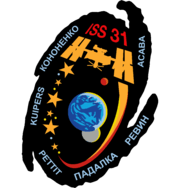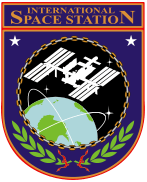Expedition 31
| Mission type | ISS Expedition | ||||
|---|---|---|---|---|---|
| Expedition | |||||
| Space Station | International Space Station | ||||
| Began | 27 April 2012, 08:15 UTC[1] | ||||
| Ended | 1 July 2012, 04:48 UTC[2] | ||||
| Arrived aboard |
Soyuz TMA-03M Soyuz TMA-04M | ||||
| Departed aboard |
Soyuz TMA-03M Soyuz TMA-04M | ||||
| Crew | |||||
| Crew size | 6 | ||||
| Members |
Expedition 30/31: Oleg Kononenko André Kuipers Don Pettit Expedition 31/32: Joseph M. Acaba Gennady Padalka Sergei Revin | ||||
  (l-r) Acaba, Padalka, Revin, Kuipers, Kononenko and Pettit
| |||||
Expedition 31 was the 31st long-duration expedition to the International Space Station (ISS). It began on 27 April 2012 with the departure from the ISS of the Soyuz TMA-22 spacecraft, which returned the Expedition 30 crew to Earth.[1] The expedition ended on 1 July 2012, when crew members Oleg Kononenko, André Kuipers and Don Pettit departed from the ISS aboard Soyuz TMA-03M, marking the beginning of Expedition 32.[2]
Crew
| Position | First part (April 2012 to May 2012) |
Second part (May 2012 to July 2012) |
|---|---|---|
| Commander | Oleg Kononenko, RSA Second spaceflight | |
| Flight Engineer 1 | André Kuipers, ESA Second spaceflight | |
| Flight Engineer 2 | Don Pettit, NASA Third spaceflight | |
| Flight Engineer 3 | Joseph M. Acaba, NASA Second spaceflight | |
| Flight Engineer 4 | Gennady Padalka, RSA Fourth spaceflight | |
| Flight Engineer 5 | Sergei Revin, RSA First spaceflight | |
Mission highlights
Soyuz TMA-22 departure
Expedition 31 formally began on 27 April 2012, with the departure from the ISS of the Soyuz TMA-22 spacecraft. Soyuz TMA-22 successfully returned Expedition 30 astronauts Dan Burbank, Anton Shkaplerov and Anatoli Ivanishin to Earth.[1] The ISS was left under the command of astronauts Kononenko, Kuipers and Pettit, who had arrived at the station aboard Soyuz TMA-03M on 23 December 2011.
Soyuz TMA-04M arrival
| Wikinews has related news: Expedition 31 crew members arrive at International Space Station |
The final three members of Expedition 31 – Acaba, Padalka and Revin – arrived at the ISS aboard Soyuz TMA-04M, which launched on 15 May 2012,[7] and docked to the ISS on 17 May at 4:36 UTC.[8]
SpaceX Dragon test mission
SpaceX's unmanned Dragon spacecraft conducted a test rendezvous with the ISS during Expedition 31, as part of NASA's Commercial Orbital Transportation Services program; it was the first commercial spacecraft to rendezvous with the ISS. Following a series of delays,[9] Dragon launched on 22 May 2012, and berthed successfully with the ISS on 25 May, after conducting a series of orbital test manoeuvres.[10][11] Dragon carried around 544 kilograms (1,199 lb) of cargo to the ISS, including food, clothing, a laptop computer and 15 student experiments.[10][12] After being loaded with 660 kilograms (1,460 lb) of downmass cargo, including completed experiments and redundant equipment, it undocked from the station and returned to Earth on 31 May 2012.[13][14] Dragon landed intact in the Pacific Ocean and was successfully recovered, allowing SpaceX to begin regular cargo flights to the ISS.[15] The first such logistics mission, CRS SpX-1, launched successfully in October 2012.[16][17]
Soyuz TMA-03M departure
Soyuz TMA-03M departed from the ISS on 1 July 2012, successfully returning Kononenko, Kuipers and Pettit to Earth. Their departure marked the formal end of Expedition 31, and the beginning of Expedition 32.[2]
In popular culture
In the 2012 The Big Bang Theory episode "The Friendship Contraction", character Howard Wolowitz revealed that he would be a member of a fictionalized Expedition 31.[18]
Gallery
 Soyuz TMA-22 departs the ISS on 27 April 2012, marking the beginning of Expedition 31.
Soyuz TMA-22 departs the ISS on 27 April 2012, marking the beginning of Expedition 31. An Orthodox priest blesses the Soyuz rocket on 14 May 2012.
An Orthodox priest blesses the Soyuz rocket on 14 May 2012. The Expedition 31 crew wave goodbye before the launch on 15 May 2012.
The Expedition 31 crew wave goodbye before the launch on 15 May 2012. The launch of Soyuz TMA-04M on 15 May 2012.
The launch of Soyuz TMA-04M on 15 May 2012. SpaceX's unmanned Dragon spacecraft approaches the ISS on 25 May 2012.
SpaceX's unmanned Dragon spacecraft approaches the ISS on 25 May 2012. Expedition 31 posing inside the docked Dragon capsule on 29 May 2012.
Expedition 31 posing inside the docked Dragon capsule on 29 May 2012.
References
![]() This article incorporates public domain material from websites or documents of the National Aeronautics and Space Administration.
This article incorporates public domain material from websites or documents of the National Aeronautics and Space Administration.
- 1 2 3 "Soyuz TMA-22 returns to Earth with three outbound ISS crewmembers". NASASpaceflight.com, 27 April 2012.
- 1 2 3 Harding, Pete (1 July 2012). "Soyuz TMA-03M undocks from ISS and returns to Earth". NASASpaceFlight (not associated with NASA). Retrieved 3 July 2012.
- ↑ NASA HQ (2009). "NASA and its International Partners Assign Space Station Crews". NASA. Retrieved 7 October 2009.
- ↑ NASA HQ (2010). "NASA And Partners Assign Crews For Upcoming Space Station Missions". NASA. Retrieved 8 July 2010.
- ↑ ESA astronaut André Kuipers to spend six months on the ISS starting in 2011
- ↑ "Expedition 31 crew page". NASA. Retrieved 18 November 2011.
- ↑ "Three New Crew Members En Route to Station". Latest News. NASA. Retrieved 2012-05-14.
- ↑ Harwood, William (17 May 2012). "Three-man crew docks at International Space Station". Spaceflight Now. Retrieved 17 May 2012.
- ↑ "SpaceX Dragon chokes at the last second". The Register. 19 May 2012. Retrieved 21 May 2012.
- 1 2 "SpaceX Launches Private Capsule on Historic Trip to Space Station". Space.com. 22 May 2012.
- ↑ "Station grabs SpaceX Dragon ship". BBC. 25 May 2012.
- ↑ "Private cargo rocket launch a giant leap for space entrepreneur". Austin American-Statesman. 23 May 2012.
- ↑ "SpaceX Dragon Capsule opens new era". Reuters via BusinessTech.co.za. 28 May 2012.
- ↑ "Splashdown for SpaceX Dragon spacecraft". BBC. 31 May 2012.
- ↑ "Its First Mission Done, SpaceX Looks to More Private Flights". New York Times. 31 May 2012. Retrieved 5 June 2012.
- ↑ Bergin, Chris (31 August 2012). "SpaceX conduct successful WDR on their latest Falcon 9". NASASpaceFlight.com. Retrieved 15 September 2012.
- ↑ "Liftoff! SpaceX Dragon Launches 1st Private Space Station Cargo Mission". Space.com. 8 October 2012.
- ↑ "The Friendship Contraction". The Big Bang Theory. Season 5. Episode 15. 2 February 2012. 02:20 minutes in.
External links
| Wikimedia Commons has media related to ISS Expedition 31. |
- NASA's Space Station Expeditions page
- End of Expedition 30/Beginning of Expedition 31 video
- Expedition 30/31 - Change of Command Ceremony video
- End of Expedition 31/Beginning of Expedition 32 video
- Expedition 31/32 - Change of Command Ceremony video
- Expedition 31 Photography
